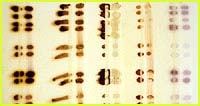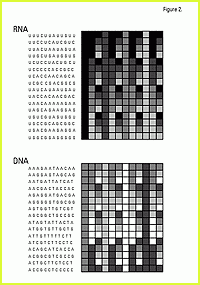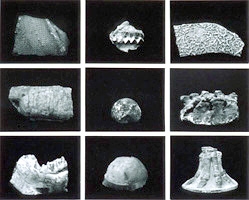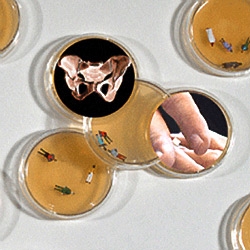Feature: Reviews
Gene(sis) at BAM
- Berkeley Art Museum
- August 27 - December 7, 2003
Yesterday I walked through Gene(sis): Contemporary Artists Examine Genomics with my friend Sheldon Shen, a cell biologist with a lab nearby on the UC Berkeley campus. I was curious to see what he would see. He saw lots of things that I had missed: he saw that Jaq Chartier’s abstract paintings resembled amino acids more than DNA; he saw significant similarities in some of Inigo Manglano-Ovalle’s DNA triptychs that enabled him to identify the biologically related trios; he saw that one of the lights shining on Eduardo Kac’s transgenic bacteria was a UV lamp that would encourage mutations.
I talked with him about the visual/verbal pun in Gregor Moebius’s DNA/RNA how his translation of letter code into values of black and white might suggest that we filter our interpretation of DNA through cultural values. I pointed out that Critical Art Ensemble reprinted quotes about the wonders of biotech in Gothic letters, making them look Biblical, as part of their satirical Cult of the New Eve and explained that when they wanted to illustrate the evolution of multiple pleasure centers they used the Venus from a great Baroque-era painting, Bronzino’s An Allegory of Time and Love because the painting is all about the many varieties of desire.
Bits of information about our different social networks also emerged. When he saw the plaque that said we were in the “Daniel Koshland” galleries, he told me that Koshland was a world-famous biochemist. We paused in front of the Creative Time coffee cups and I said they had been distributed to cafes in a kind of public art. He nodded and said that was better than getting a poker card — when I looked puzzled, he explained that vending machine coffee sometimes comes with poker cards printed on the bottom, you can buy coffee with a friend and see who wins the draw. I concluded that lab scientists drink more vending machine coffee than artists do.
Then he went back to his lab, and I had little quiet time with the show. I was drawn back to Catherine Wagner’s Fossils. As she photographs them, the bare objects are so obdurately strange. When the enfolding context of labels, displays, and environment is stripped away, it seems that we really cannot know them, or rather there is no end to our knowing, because we keep comparing, rearranging, and explaining the same objects in different ways.
The objects in the exhibition — the individual artworks — are no different than those fossils. I had just experienced the way in which my friend and I built explanations around the objects we saw, explanations that varied radically based on our experiences. They weren’t necessarily contradictory, but they were different. The differences were fun and instructive for us — we’re friends, we’re disposed to be kind and appreciative to each other. But they could be a problem in a situation where the parties emphasized power rather than communication. Even for friends, things could break down quickly. Say, if I claimed authority as an art critic to say that his observations on Chartier’s abstractions “missed the point.” Or if he claimed authority as a molecular biologist to deride the metaphorical use of electrophoretic gels. It’s no secret that an atmosphere of mutual respect is a difficult atmosphere for humans to maintain for more than a few seconds, especially when they think something important is at stake — say, something like the future evolution of humankind.
As I chugged along this train of thought, Gail Wight’s digital projection loomed larger and larger. On the screen is a scatter of Petri dishes viewed from above. In each dish are what at first appear to be chromosomes, that on closer inspection resolve into human bodies. The relative scale of the images is such that they jump between references — if you focus on the big picture, you see chromosomes, if you zero in on a specific dish, you see the human forms. This poetic visual linkage leads, via a mouse click, into someone’s story related to genetics — for example, Ignacio Chapela’s encounter with intimidating government officials in Mexico. Each story is presented with equal emphasis; each story becomes part of the whole picture. I see this piece as a model of the process of investigation that serves us best, when as people who happen to practice as artists or scientists, we negotiate our new ability to compose biology.




